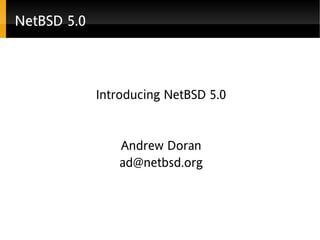
Introducing NetBSD 5.0
- 1. NNNNNNeeeeeetBtBtBtBtBtBSDSDSDSDSDSD 555555......000000 Introducing NetBSD 5.0 Andrew Doran ad@netbsd.org
- 2. WWWWWWhhhhhhaaaaaatttttt iiiiiissssss NeNeNeNeNeNettttttBSBSBSBSBSBSDDDDDD?????? A mature Unix-like operating system. Focus areas: Server, embedded, and hobby applications. Scaling: from mobile phones to large servers. Providing a platform for education and research. Development coordinated by one of the first truly collaborative Open Source projects to emerge on the net.
- 3. WWWWWWhhhhhhaaaaaatttttt iiiiiissssss NeNeNeNeNeNettttttBSBSBSBSBSBSDDDDDD 555555......000000?????? The first NetBSD release to see full-time development funded by donations. The largest set of changes to the kernel since the inception of the project. A seven million line patch against 4.0. Over 2 years in development.
- 4. EmEmEmEmEmEmbbbbbbeeeeeeddddddddddddeeeeeedddddd rolrolrolrolrolroleeeeee An important market segment that helps to drive the system's development, so I'll mention it here. Popular because the system scales well, the price and license are right, and it's easy to build upon. Build any NetBSD platform from anywhere with a POSIX environment and C/C++ compiler: from Solaris, Linux, Windows (Cygwin), ... $ uname s m Linux i686 $ cd netbsdsrc $ ./build.sh m sparc64 release
- 5. NeNeNeNeNeNewwwwww iiiiiinnnnnn 555555......000000 Massive performance improvements on multicore hardware. Journaling file system. Power management: reliable suspend and resume. Robust 1:1 threading implementation. POSIX real-time extensions. Processor sets, affinity, and offline/online. Full kernel preemption for real-time threads. File systems (including FUSE) running in user space. Multiprocessor optimized malloc() for applications.
- 6. NeNeNeNeNeNewwwwww iiiiiinnnnnn 555555......000000 ((((((ccccccononononononttttttiiiiiinnnnnnuuuuuueeeeeedddddd)))))) Integrated LDAP (OpenLDAP). POSIX asynchronous I/O and message queues. Modularized thread scheduler. Writable file systems on DVDs (UDF). Extensive bug audit of core kernel code. Many new runtime tuneables. And much more!
- 7. NeNeNeNeNeNewwwwww fffffforororororor workworkworkworkworkworkssssssttttttaaaaaattttttiiiiiionononononon uuuuuusssssseeeeeersrsrsrsrsrs Fast boot: ~20 seconds from loader to GDM login prompt on modern PCs. Suspend and resume many laptops reliably, even multi-core. Threaded applications can exploit the power of all CPUs. Notable examples: video and audio transcoding. Unified kernel image for native x86. There is now rarely any need to compile a custom one. Self-optimizing kernel: no penalty running on a single CPU machine. Xorg to replace XFree86.
- 8. ............ forforforforforfor sssssseeeeeerrrrrrvvvvvversersersersersers aaaaaannnnnndddddd eeeeeemmmmmmbbbbbbeeeeeeddddddddddddeeeeeedddddd aaaaaappppppppppppssssss Performance and reliability improvements almost everywhere. Scale from 1 to 32 CPUs with no tweaks on qualified workloads. Partition CPU resources as needed. Example: dedicate CPUs to your realtime applications. Realtime applications take advantage of kernel preemption (~5μs typical response on modern x86). Logging file system: no more waiting for file system checks after an unscheduled system shutdown.
- 9. ............ forforforforforfor ddddddeeeeeevvvvvveeeeeellllllopopopopopopeeeeeersrsrsrsrsrs aaaaaannnnnndddddd hhhhhhobobobobobobbbbbbbyyyyyyisisisisisisttttttssssss Many new application facilities and APIs. Example: Solaris- compatible atomic operations, with the same API in both kernel and userspace. Native Java on i386 and soon amd64. cc -m32: develop and test 32 bit applications on 64-bit hosts. Extensive updates to the kernel programming guide - “section 9” of the system manual. ATF: the Automated Testing Framework, for unit tests. Better insight into how the system is performing and operating, with new tools such as lockstat (kernel lock statistics), tprof (performance-counter based kernel profiling), and mini crash dumps on i386 (no more 4GB kernel crash dumps).
- 10. BeBeBeBeBeBennnnnncccccchhhhhhmmmmmmaaaaaarkrkrkrkrkrkssssss To illustrate performance improvements in 5.0. Release versions of each OS installed and are: “out of the box”, with no tweaking. using hand-compiled software where important for fairness. using similar file system configurations: 4GB /local with journaling or soft updates, tmpfs /tmp using identical application configurations Your results may differ, terms and conditions apply, etc.
- 11. BeBeBeBeBeBennnnnncccccchhhhhhmmmmmmaaaaaarkrkrkrkrkrk:::::: hhhhhhaaaaaacccccckkkkkkbbbbbbeeeeeennnnnncccccchhhhhh Tests efficiency and scalability of the scheduler and IPC mechanisms. Created by and popular with Linux kernel developers. Exposes problems with SMP scaling, and with high numbers of active tasks.
- 13. BBBBBBenenenenenencccccchhhhhhmmmmmmaaaaaarrrrrrkkkkkk:::::: MySMySMySMySMySMySQQQQQQLLLLLL ssssssysysysysysysbbbbbbeeeeeennnnnncccccchhhhhh Simulates an OLTP style workload. Tests efficiency and scalability of pthread library, malloc(), the scheduler and IPC mechanisms, among others. Used extensively during development of 5.0. Run here in read-only configuration: write performance of the DBMS and disk subsystem is a limiting factor we are not interested in for this particular test. my.cnf available on request.
- 15. BeBeBeBeBeBennnnnncccccchhhhhhmmmmmmaaaaaarkrkrkrkrkrk:::::: bbbbbbuuuuuuiiiiiilllllldddddd......sssssshhhhhh NetBSD's build system. A “software development” workload. All tools bootstrapped: compiler, binutils, make, etc. The only host tool that sees extensive use is /bin/sh. In this test, a hand built gcc is used to bootstrap (for fairness). Measures time taken to build a release of NetBSD in seconds: smaller is better. Fedora excels due to massive investment in improving efficiency and scalability of Linux over the last few years. Our hats are off to the GNU/Linux/Fedora developers. We want to reverse the position with 6.0.
- 16. “build.sh -j 16 -m i386 release”, 8 core Xeon E5320 Time in seconds
- 17. TTTTTThhhhhheeeeee fufufufufufuttttttuuuuuure:re:re:re:re:re: ppppppososososososssssssiiiiiibbbbbblllllleeeeee ffffffeaeaeaeaeaeattttttuuuuuurerererereressssss fffffforororororor 666666......000000 Concurrent network stack. 255 core support on x86. ZFS, Sun's new file system. 15 minutes from install CD to desktop with web and productivity apps. Further performance and scalability improvements to file and virtual memory subsystems. Modularized kernel on PC and server systems. NUMA awareness. Binary patches and upgrades. NFS client performance improvements.